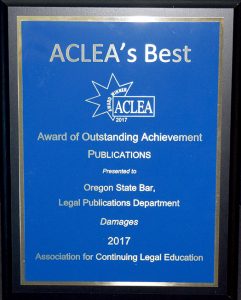 OSB Legal Publications has once again been recognized for our commitment to publishing quality legal resources. We received an award for a book we released in 2016.
OSB Legal Publications has once again been recognized for our commitment to publishing quality legal resources. We received an award for a book we released in 2016.
The Association for Continuing Legal Education (ACLEA) has selected Damages as the winner of its ACLEA’s Best Award of Outstanding Achievement in Publications. A plaque commemorating the award was presented at ACLEA’s Annual Meeting in Montreal, Quebec, Canada in August and is on display in the lobby of the OSB Center.
Of course, Legal Pubs couldn’t have created this highly informative and innovative book without the help of our three volunteer editorial board members Hon. Karsten Rasmussen, Rick Lee, and Heather Bowman.
Damages was designed to support Oregon attorneys in their role as litigator and advisor. Whether the attorney is a recent law grad or a seasoned attorney, there is something in here for them. This publication was made possible only through the extraordinary dedication and gratuitous contribution of time and talent offered by 50 Oregon attorneys. The accomplished attorneys who drafted each chapter offered their insights—starting with an overview of the particular practice area or basis for money damages, and drilling down into the most relevant details that practicing attorneys are likely to encounter in their practice. The authors included practice tips and caveats where appropriate. Many authors also provided references to other resources, which are often helpful springboards when greater depth of understanding in a nuanced area of the law is necessary.
The authors who volunteered their time and talent on this publication and made an ACLEA award possible are Allen E. Eraut, Julie A. Smith, Joshua Sasaki, Megan McGuire, Laura C. Johnson, David Auxier, Ted Reuter, Bernard S. Moore, Samuel T. Smith, Joshua D. Stadtler, Jeffrey D. Munns, Nicholas E. Wheeler, James C. Edmonds, Jeffrey A. Trautman, Donald E. Templeton, Frederick H. Lundblade, III, Jennifer Middleton, Meredith Holley, Hon. Benjamin M. Bloom, Thomas M. Triplett, Keith S. Dubanevich, Nadine A. Gartner, W. Greg Lockwood, Carson D. Bowler, Michelle G. Rudd, Reilley D. Keating, Jay W. Beattie, Gavin W. Bruce, Emily S. Miller, D. Gary Christensen, Cody Berne, Robert Lane Carey, Lindsay L. Reynolds, Sarah M. Einowski, Jeff Bradford, Rima I. Ghandour, Erin E. Gould, Bryan P. Murphy, Justine Fischer, Thomas C. Peachey, Andrew J. Myers, Michael B. Hallinan, Sara Kobak, Jordan R. Silk, James Coon, Gordon T. Carey, Jr.
The editorial review board, authors, and in-house editors have produced a deskbook that is practical, comprehensive, and well-supported with citations to legal authorities. It filled an ever-present need for up-to-date information on the law of damages in a variety of areas of law. Because of the quality of the publication and its unique place in the market it has become an invaluable resource for Oregon lawyers.